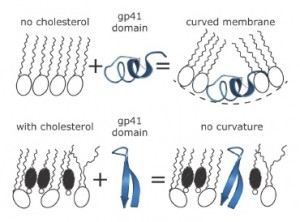
Model of conformational change in the HIV gp41 fusion protein induced by cholesterol composition of lipid monolayers.
In biological systems, membranes are as important as water. They form the barrier between the inner world, within our cells, where we perform the chemical reactions of life, and the outside environment.
But a biological membrane isn’t just a big container that keeps the world at bay, it is a vital, interactive gateway that sends and receives goods and messages in a highly regulated and specific way.
Membranes are known to perform their amazing functions through the interactions of proteins and lipids within the lipid bilayer.
Researchers who study membrane-driven processes such as synaptic communication, sperm-egg fusion, and viral infection have focused on the ways that proteins can regulate lipids to control membrane curvature to form the vesicles, pores, and tubules required for these processes.
Now, through advances in liquid surface x-ray scattering techniques at the X-ray Science Division 9-ID beamline at the U.S. Department of Energy Office of Science’s Advanced Photon Source at Argonne National Laboratory, IIT Associate Professor of Physics David Gidalevitz, postdoctoral fellow Andrey Ivankin, and Ivan Kuzmenko from Argonne have discovered that lipids are also influencing the shapes of the proteins in the membrane and contributing to membrane curvature. Their research is published in Physical Review Letters.
Read more at the Argonne National Laboratory website.
See: Andrey Ivankin, Ivan Kuzmenko, and David Gidalevitz, “Cholesterol Mediates Membrane Curvature during Fusion Events,” Phys. Rev. Lett. 108, 238103 (2012). DOI:10.1103/PhysRevLett.108.238103
